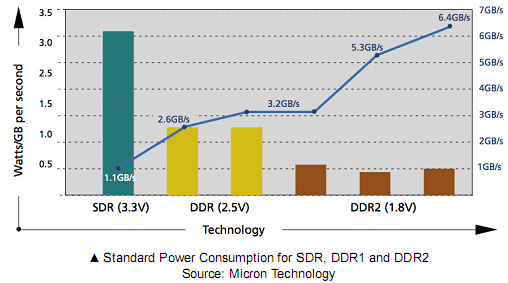
The Second Generation: DDR2
DDR2 is expected to be the most common memory standard for computers until 2009. DDR2 desktop modules consist of a 240-pin connection interface.
DDR2 is standardised to run at 1.8V by JEDEC, however, some manufacturers have certified their enthusiast-focused high performance modules to perform at voltages up to 2.4V while still remaining within their warranty coverage. Many budget modules come without elaborate cooling techniques and should be ran at a much lower voltage for long-term operational reliability as the extra heat from the extra voltage is not dissipated as effectively.
We recently asked Brett Williams, Senior Marketing Manager for Computing at Micron Technology about higher DRAM voltage and the effects on lifespan. For example, we asked about a typical memory module running at 2.0V; “[it] would actually have a lower lifespan than the 1.8V module. Now, when I say ‘lower life’… that may or may not be a concern for you. At 1.8V that module might work up to 200 years. At 2.0V that might work up to 10 years. But you are probably going throw your system away after three to five years: change the memory or upgrade.”

DDR2 is specified by the JEDEC to perform up to 800MHz with a given set of requirements, hence speeds beyond 800MHz are specified as being out of the industry standard and require specific support from motherboard vendors.

It is important to note that JEDEC specifications are based on parameters with healthy levels of ‘safety’ margins. This is to allow any JEDEC specified RAM to accommodate the widest range of motherboards and chipsets and in this respect JEDEC DDR standard has more to do with signalling reliability rather than memory speed.
The improving power versus throughput ratio measured in watts per gigabyte per second is a positive trend, but many DDR2 desktop motherboards (BIOS) and memories (SPD) are pre-programmed at the factory to run at 1.85V to 1.95V to counter wider stability problems.
An industry exception worth mentioning is a special class of Micron’s 1,066MHz DDR2 DRAM with a native 1.8V that still falls within the JEDEC requirements. Normally only 800MHz memory is rated for 1.8V but this is the only native 1,066MHz DRAM in the DDR2 market – making it particularly suitable for AMD’s new Phenom CPUs that run with a 1,066MHz memory speed, as well as overclocking.
Brett Williams explains how Micron achieved this by trying to “build in significant margins.” He informs us that fundamentally Micron’s D9 is on a more advanced fabrication process than a lot of its competitors: 78nm at Micron versus 95nm elsewhere. “It is a combination of process and design techniques that have helped Micron in reaching higher memory frequency while maintaining the widest signalling margins.” Kirstin Bordner of Micron Technology provided us the specific D9 designators to look out for that indicate 1.8V 1,066MHz DRAMs.
- D9HCD MT47H64M8B6-25:D
- D9GKX MT47H64M8B6-25E:D
- D9GMH MT47H64M8B6-3:D

MSI MPG Velox 100R Chassis Review
October 14 2021 | 15:04









Want to comment? Please log in.